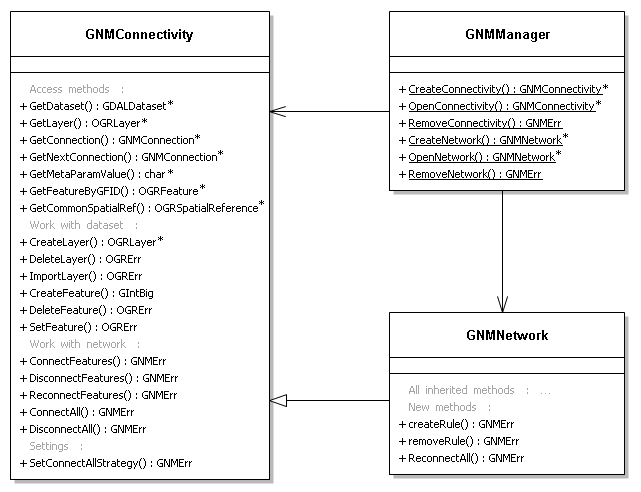I suppose, that implementing a network functionality as a GDAL driver has the following disadvantages:
- The concept of driver in general is to provide a "bridge" between GDAL abstraction and the real data format. There is no network format itself, because every vector format stores the network (or simply connectivity) together with spatial objects or in the separate set of layers but anyway the same format.
- An implementation of a new GDALDataset must be generic and implement only the defined interface, while we need to add new network functionality.We will need to do a type cast if we want to use network methods of the new GDALDataset.
- Network is usually built over the ready set of spatial data. In case of driver there is a need firstly to create a void network and then import some layers from external data sets.
- If we inherit the GDALDataset a lot of unnecessary for networks methods, such as working with rasters, will be inherited too.
- Some drivers, which serves as an "inner" for networking driver does not support several layers, such as GeoJSON, so there is no capability to create a network over them, while this requires several layers.
- I also suppose that some mechanisms of network model extensions, which I've implement in my driver are a bit excess and I think it is unnecessary to include it into GDAL library.
The separate class GNMConnectivity represents a network as an object and aggregates a GDALDataset instance, but not inherits it. The network data and spatial/attribute in fact are not separable (just additional layers or fields), while the GNMConnectivity "knows" which data from the data set refers to network data and operates it. The network can be built only over the existing data set (though, it can be void), wrapping it and adding missing network layers/field.
All network functionality in GDAL will be split to two levels: GNMConnectivity (level 0) and GNMNetwork (level 1). The 0 level represents a simple graph (simple connectivity or topology) which holds the connections among features. The level 1 is based on the level 0 and adds the support of network's business logic. For each level the default network functionality will be provided for any GDAL-supported vector format (at first actually for several), as it is now in my driver.
The derived classes intend to provide a support of native networking of different formats as an alternative to default. Some of these formats (like pgRouting or GML) have just connectivity capabilities without any business logic support, while others (Oracle Spatial, GDF or even ArcGIS networks) have the concept of network constraints (connectivity rules, turn restrictions). The main point is that GNMConnectivity / GNMNetwork provides the generic interface for these network formats, like GDAL provides the generic interface for spatial formats.
The derived classes also define how the network data stores in its format. For example for SpatiaLite VirtualNetwork the according "driver" will write all network data to the Roads_net_data table and to corresponding NodeFrom and NodeTo columns. If use of such "driver" hadn't been selected - the corresponding network_ layers in this simple SpatiaLite data set will be created (see my previous posts about how the network is stored). Another example: in the native form the GML "driver" will write network data to the <gml::TopoComplex>, <gml::Node> and <gml::Edge>.
API
This is a set of classes with public functions, which should be used:
Take a look at detailed description of classes, methods and its parameters:https://github.com/MikhanGusev/gnm/blob/master/gnm.h
C API: https://github.com/MikhanGusev/gnm/blob/master/gnm_api.h
network2network
The following code can be an example of using GDAL network API. It is a part of possible future utility network2network which converts the networks of different formats:
void main (void)
{
//...
// poPGDS initialized as a PostGIS Dataset. It has spatial data and connectivity
// over it already.
// poShpDS initialized as a Shapefile Dataset. It has all corresponding spatial data
// (with the same GFIDs also), or the process of network copying will fail or be incorrect.
GNMConnectivity *poPGCon = GNMManager::OpenConnectivity(poPGDS,TRUE);
if (poPGCon == NULL) return;
OGRSpatialReference *poSRS = poPGCon->GetCommonSpatialRef();
GNMConnectivity *poShpCon = GNMManager::CreateConnectivity(poShpDS,poSRS,NULL);
if (poShpCon == NULL) return;
GNMConnection *con;
poPGCon->ResetReading();
while ((con = poPGCon->GetNextConnection()) != NULL)
{
GNMErr err = poShpCon->ConnectFeatures(con->nSourceGFID,
con->nTargetGFID
con->nConnectorGFID
con->dDirCost,
con->dInvCost,
con->dir);
delete con;
if (err != GNMERR_NONE)
{
poShpCon->DisconnectAll();
return;
}
}
// The correct resources freeing.
//...
}















